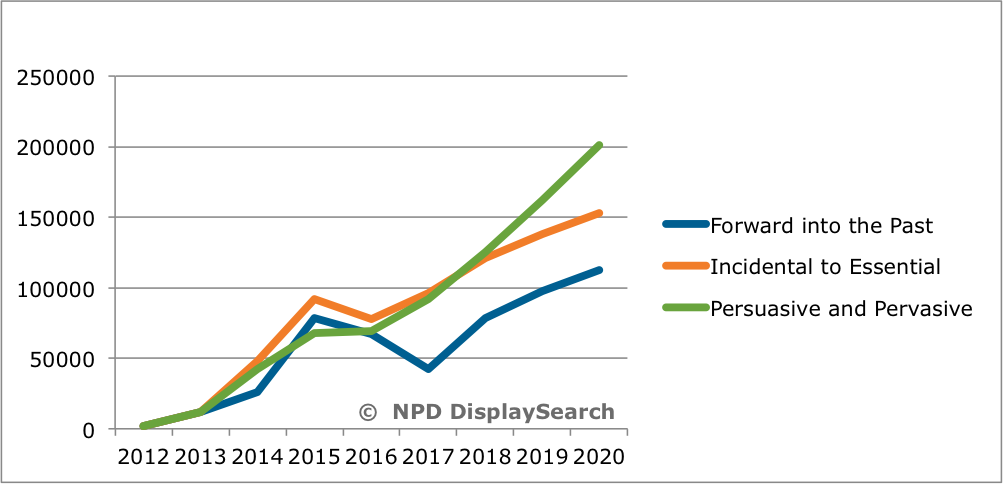Wearable Device Market Growth to be Bumpy as Value Proposition is Established, NPD DisplaySearch Reports
Santa Clara, Calif. (PRWEB) May 22, 2014 -- The market for wearable devices, like activity trackers, notifier bands, smart watches, and head-mounted displays, first took off in 2013, and momentum could drive the market as high as 48 million units this year and 91 million in 2015. However, based on research in the NPD DisplaySearch Wearable Device Market and Forecast Report, the market is expected to experience a slow down after 2015, as consumers rebound from the initial hype.
“We expect that the dynamics of the wearables market will be similar to DVD, LCD TV, smartphones, and other digital consumer markets with commoditized hardware,” according to Paul Gray, director of European TV research for NPD DisplaySearch. “The arrival of Samsung, LGE, and other large, cost-efficient manufacturers to the wearables market would bring prices and margins down.”
Given the significant uncertainties in consumer adoption, retention, and product development, NPD DisplaySearch developed three scenarios for the market forecast: Forward into the Past, Incidental to Essential, and Persuasive and Pervasive. The expected slowdown, and subsequent return to stronger growth, is evident in all three scenarios.
The “Forward into the Past” Scenario
In the first forecast scenario, “Forward into the Past,” wealthy early adopters are the first owners, and these high-status individuals reinforce the desirability of wearable devices. Market adoption eventually trickles down to less tech-enabled consumers as prices drop, but as fashion fades, the market shrinks dramatically before becoming established. Over time, continued price erosion leads to market expansion.
In this scenario, China is expected to dominate demand due to its huge market and strong smartphone uptake; however, a strong fashion effect would cause a surge and then backlash in China in 2017. North America and Europe would experience a slower decline than China in 2017. “Chinese shipments would then accelerate later in 2017, as unbranded and local suppliers gain share by selling wearable devices at low prices,” Gray said.
The “Incidental to Essential” Scenario
In the second forecast scenario, “Incidental to Essential,” what starts out as a casual purchase becomes essential, due to the intrinsic usefulness of wearable devices. Like Apple’s iTunes, consumers become locked-in, and loyal to, combinations of devices and services.
In this scenario, China again dominates demand, for the same reasons; however, in this scenario a more limited fashion effect causes a surge and then decline in China in 2016. The decline is limited in North America and Europe by the dominance of a few brands that can maintain sales by bundling strategies. China accelerates in the later part of the forecast, as unbranded and local suppliers gain share. Strong branded offerings cause a market surge in all regions, especially North America, where adoption is locked in. “Driven by an early shrinkage in 2016, consolidation is rapid, allowing a small number of brands to strengthen their positions,” Gray noted.
The “Persuasive and Pervasive” Scenario
The “Persuasive and Pervasive” forecast scenario reveals a more positive shipment outcome than the “Incidental to Essential” scenario, in that the health benefits of wearable devices become significant, while body sensing becomes a critical part of everyday life – triggering medical intervention, providing security and identification, and even daily living assistance – and private and public healthcare providers recommend wearable technologies to their patients.
While China again dominates demand in the longer term, it would be relatively slow to grow. In this scenario the fashion effect would again be minimal, as the primary driver in the market is healthcare applications; the market is forecast to plateau in 2016, but does not decline overall. North America is the earliest adopter of wearables, reinforced by social networking. Chinese market growth would accelerate again in 2017, as local suppliers gain share at lower prices. “Increased concern about healthy living in China, and similar concerns in Europe, could lead healthcare providers to recommend activity-tracker devices to their patients,” Gray said.
Covering activity trackers, notifier bands, smart watches, and head-mounted displays, The NPD DisplaySearch Wearable Device Market and Forecast Report is the only resource that provides three forecasting scenarios and conditions for success, as well as insight into the most successful business models in the United States, China, Japan, Germany, and the U.K. For more information about the report, please contact Charles Camaroto at 888-436-7673 or 516-625-2452, e-mail contact(at)displaysearch(dot)com or contact your regional NPD DisplaySearch office in China, Japan, Korea or Taiwan for more information.
About NPD DisplaySearch
NPD DisplaySearch, part of The NPD Group, provides global market research and consulting specializing in the display supply chain, including trend information, forecasts and analyses developed by a global team of experienced analysts with extensive industry knowledge. NPD DisplaySearch supply chain expertise complements sell-through information from The NPD Group, thereby providing a true end-to-end view of the display supply chain from materials and components to shipments of electronic devices with displays to sales of major consumer and commercial channels. For more information, visit us at http://www.displaysearch.com. Read our blog at http://www.displaysearchblog.com and follow us on Twitter at @DisplaySearch.
About The NPD Group, Inc.
The NPD Group provides global information and advisory services to drive better business decisions. By combining unique data assets with unmatched industry expertise, we help our clients track their markets, understand consumers, and drive profitable growth. Practice areas include automotive, beauty, consumer electronics, entertainment, fashion, food/foodservice, home, luxury, mobile, office supplies, sports, technology, toys, and video games. For more information, visit npd.com and npdgroupblog.com. Follow us on Twitter at @npdtech and @npdgroup.
Lee Graham, The NPD Group, 212-333-4983, [email protected]

Share this article